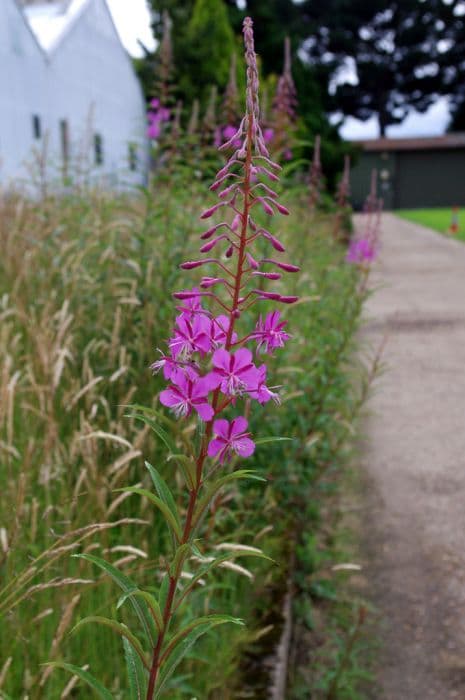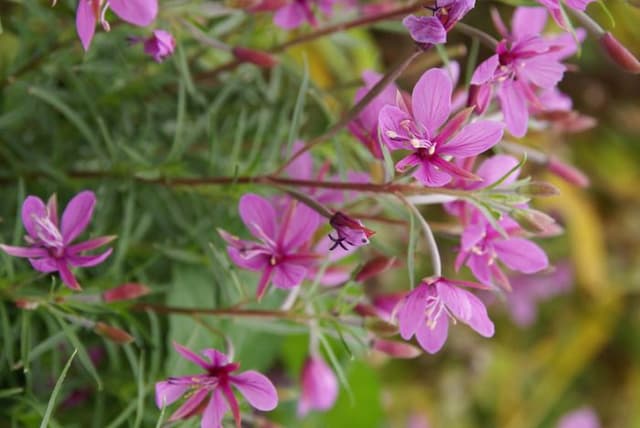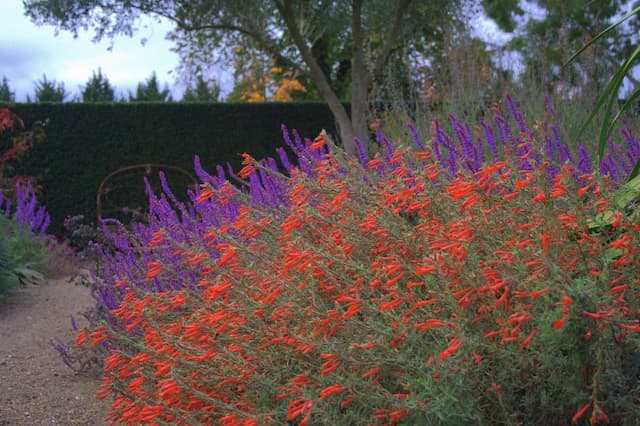Fuchsia Fuchsia 'Chang'

ABOUT
Fuchsia 'Chang' is a striking ornamental plant famed for its beautiful hanging flowers that display a stunning blend of vibrant colors. The blooms are a signature characteristic, usually teardrop-shaped and dangly, making an exquisite display. These flowers are composed of a couple of layers; the outer petals form a graceful skirt in a lovely shade of purple or pink, while the inner petals, often a vivacious shade of deep purple to pink, elegantly flare out and dangle beneath the skirt. Attached to these petals are long, slender stamens that protrude gracefully from the flower's center, adding to the plant's delicate and intricate appearance. The foliage of Fuchsia 'Chang' is also quite appealing, providing a lush backdrop for the dramatic flowers. The leaves are typically oval with pointed tips and are arranged opposite each other on the plant's stems. Their color varies from dark green to a softer, more muted green, and they may have a subtle vein pattern that creates a textured visual effect. The stems are sturdy yet flexible, allowing the branches to sway gently when laden with the weight of the flowers. In ideal conditions, Fuchsia 'Chang' can become quite a spectacle, with a profusion of flowers cascading down in a dramatic floral display. It is a favored choice for gardeners looking to add a splash of color and elegance to hanging baskets, containers, or garden borders. This plant truly embodies a delicate and exotic aesthetic, with its distinct flowers lending a touch of the extraordinary to any space they grace.
About this plant
 Names
NamesFamily
Onagraceae.
Synonyms
Fuchsia 'Chang', Ladies' Eardrops, Fairy Bells, Hummingbird Fuchsia.
Common names
Fuchsia 'Chang'.
 Toxicity
ToxicityTo humans
Fuchsia plants, including the 'Chang' variety, are generally considered non-toxic to humans. However, as with any plant, individual sensitivity can vary, and it is possible for someone to have a mild reaction if they have specific allergies or sensitivities. If ingested, fuchsia plants are unlikely to cause serious harm or symptoms of poisoning. It is always best to avoid eating ornamental plants as a precaution.
To pets
Fuchsia plants, including the 'Chang' variety, are generally considered non-toxic to pets such as dogs and cats. There is no widespread evidence to suggest that fuchsias, including their berries and flowers, cause serious harm or poisoning in pets. However, individual animals may react differently, and it is possible for a pet to experience mild gastrointestinal upset after ingesting plant material if they are not accustomed to it. It is always safest to prevent your pets from consuming non-food plants to avoid any potential issues.
 Characteristics
CharacteristicsLife cycle
Perennials
Foliage type
Deciduous
Color of leaves
Varies
Flower color
Mixed
Height
1-2 feet (0.3-0.6 meters)
Spread
1-2 feet (0.3-0.6 meters)
Plant type
Shrub
Hardiness zones
9
Native area
Central and South America
Benefits
 General Benefits
General Benefits- Aesthetic Appeal: The Fuchsia 'Chang' is known for its striking appearance and beautiful pendulous flowers which add vibrant color to gardens and landscapes.
- Attracts Pollinators: The plant is attractive to hummingbirds and beneficial insects, which are important for pollination in the garden ecosystem.
- Versatility in Landscaping: Fuchsias can be used in a variety of ways including hanging baskets, container gardening, or as accent plants in borders.
- Shade Tolerance: This plant is capable of thriving in partial shade, making it a good option for gardens with limited direct sunlight.
- Long Blooming Period: Fuchsia 'Chang' tends to have a prolonged flowering season, offering visual interest throughout the growing months.
- Relatively Low Maintenance: Once established, fuchsias require minimal care, making them suitable for gardeners of all levels of experience.
 Medical Properties
Medical PropertiesThis plant is not used for medical purposes.
 Air-purifying Qualities
Air-purifying QualitiesThis plant is not specifically known for air purifying qualities.
 Other Uses
Other Uses- Fuchsia 'Chang' can be used as a natural dye for fabrics, providing various shades of pink or purple depending on the mordant used.
- The flowers of Fuchsia 'Chang' are edible and can be used as a colorful garnish in salads or desserts for an exotic touch.
- These plants can be cultivated as bonsai, offering a challenging and rewarding hobby for gardeners and plant enthusiasts.
- Fuchsia 'Chang' can be a model organism for botanical studies due to their interesting reproductive system and flower structure.
- The pendulous flowers of the fuchsia can inspire artists and designers, influencing patterns in fashion and textiles with their unique shape and color.
- The plant can be incorporated into educational activities for children, teaching them about plant growth and care through hands-on gardening.
- Fuchsia 'Chang' can be used as part of a natural insectary garden, attracting pollinators such as bees and hummingbirds to the area.
- The wood from pruned fuchsia branches can be used in miniaturized craft projects, like fairy gardens or small-scale sculptures.
- In photography, Fuchsia 'Chang' can be used as a vibrant, living backdrop for portraits and macro photography subjects.
- During festive seasons, fuchsia branches can add a touch of natural beauty to holiday wreaths and decor without the traditional evergreen foliage.
Interesting Facts
 Feng Shui
Feng ShuiThe Fuchsia is not used in Feng Shui practice.
 Zodiac Sign Compitability
Zodiac Sign CompitabilityThe Fuchsia is not used in astrology practice.
 Plant Symbolism
Plant Symbolism- Confiding Love: The fuchsia is often associated with confiding love, as its delicate hanging blooms may suggest trust and a deep emotional connection.
- Good Taste: The elegant and vibrant colors of the fuchsia often symbolize good taste and sophistication, which also alludes to the plant’s popularity in Victorian gardens where aesthetics and propriety were highly valued.
- Elegance and Gracefulness: The fuchsia's graceful drooping flowers are reminiscent of a dancer and often represent elegance and grace.
- Ardent Affection: The rich colors and striking appearance of the fuchsia can symbolize ardent affection, conveying a strong and passionate emotion.
- Amiability: With its charming flowers and friendly appearance, the fuchsia can represent amicability and goodwill.
 Water
WaterFuchsia 'Chang', commonly known as Fuchsia, prefers consistently moist soil but not waterlogged. Water the plant when the top inch of soil feels dry to the touch, which may be roughly once or twice a week, depending on the climate and the environment. Use room temperature water and apply it directly to the soil to avoid wetting the foliage, which can lead to fungal diseases. Each watering session should thoroughly soak the soil until you see water draining from the bottom of the pot. On average, for a medium-sized plant, this might equate to about 16-24 ounces of water every week, but adjust based on the plant's response and the weather conditions.
 Light
LightFuchsia 'Chang' thrives in bright, indirect light but can tolerate partial shade. It's best positioned in a spot where it receives morning sunlight and afternoon shade, as the intense midday sun can scorch its delicate leaves. An east or north-facing window is ideal for these plants indoors, ensuring they get enough light without direct exposure to the harsh sun.
 Temperature
TemperatureFuchsia 'Chang' prefers a cool to moderate temperature range, ideally between 60 and 75 degrees Fahrenheit for optimal growth. It can survive minimally at temperatures as low as 50 degrees Fahrenheit and as high as 80 degrees Fahrenheit, but prolonged exposure to extremes can be detrimental. Providing a consistent temperature within the ideal range will promote healthy growth and flowering.
 Pruning
PruningFuchsia 'Chang' benefits from regular pruning to promote bushier growth and more flowers. Prune in late winter or early spring, before new growth begins, to shape the plant and remove any dead or damaged wood. Trimming back the tips of the stems after a flush of blooms can encourage a second blooming period. For a healthy plant, prune up to one-third of the branches each year.
 Soil
SoilFuchsia 'Chang', commonly known as Fuchsia, thrives in a soil mix that is well-draining, fertile, and rich in organic matter. A blend of one part peat or coir, one part perlite, and one part loamy soil works well. The soil pH should be slightly acidic, around 6.0 to 7.0.
 Repotting
RepottingFuchsia 'Chang', or simply Fuchsia, should be repotted every two to three years, or when it becomes root-bound in its current container. This promotes healthy growth and blooming.
 Humidity & Misting
Humidity & MistingFuchsia 'Chang', also known as Fuchsia, prefers high humidity levels, typically between 60-70%. Good airflow is also important to prevent diseases.
 Suitable locations
Suitable locationsIndoor
Place Fuchsia 'Chang' in a bright, indirect light, and maintain high humidity.
Outdoor
Fuchsia 'Chang' needs partial shade and protection from strong winds.
Hardiness zone
6-11 USDA
 Life cycle
Life cycleThe Fuchsia 'Chang', also known as Hardy Fuchsia, begins its life cycle with seed germination which occurs in warm, moist soil conditions, often in early spring. Following germination, seedlings emerge and gradually develop into young plants, exhibiting the characteristic fuchsia foliage and beginning to establish a root system. As the plant matures, it enters a vegetative growth stage where leaves and stems proliferate, and it prepares for the flowering phase. The flowering stage typically occurs in the summer and can continue into fall, where the plant produces distinctive pendulous flowers, often in shades of pink, purple, and white, attracting pollinators. After pollination, the flowers develop into small fruit-bearing seed pods, which eventually release seeds, completing the reproductive cycle. In regions with cold winters, Fuchsia 'Chang' enters a period of dormancy, during which above-ground growth dies back, and the plant survives through its root system until favorable conditions return in spring.
 Propogation
PropogationPropogation time
Spring-Early Summer
The most popular method for propagating the Fuchsia 'Chang' is through softwood cuttings, typically done in late spring to early summer when the plant is actively growing. To start, take a cutting of about 4 to 6 inches (10 to 15 cm) long from a healthy stem that has a few leaves. Remove the lower leaves, and dip the cut end into rooting hormone to encourage root growth. Then, plant the cutting in a pot filled with a moistened mix of peat and perlite, ensuring that at least two nodes are beneath the soil surface where roots will form. Cover the pot with a plastic bag or place it in a propagator to maintain high humidity, and keep it in a warm spot with indirect light. In a few weeks, the cuttings should root and can then be transplanted into individual pots to grow on.









